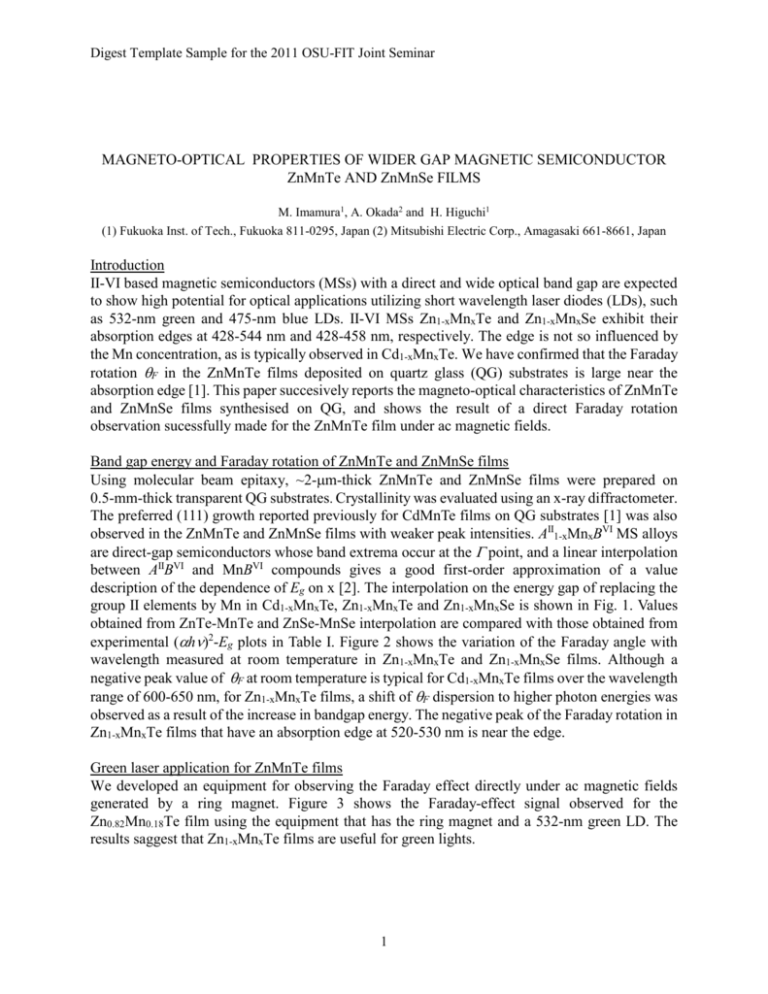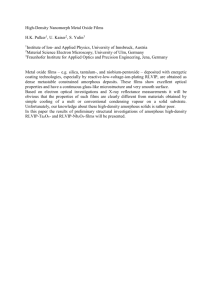MAGNETO-OPTICAL PROPERTIES OF WIDER GAP MAGNETIC
advertisement

Digest Template Sample for the 2011 OSU-FIT Joint Seminar MAGNETO-OPTICAL PROPERTIES OF WIDER GAP MAGNETIC SEMICONDUCTOR ZnMnTe AND ZnMnSe FILMS M. Imamura1, A. Okada2 and H. Higuchi1 (1) Fukuoka Inst. of Tech., Fukuoka 811-0295, Japan (2) Mitsubishi Electric Corp., Amagasaki 661-8661, Japan Introduction II-VI based magnetic semiconductors (MSs) with a direct and wide optical band gap are expected to show high potential for optical applications utilizing short wavelength laser diodes (LDs), such as 532-nm green and 475-nm blue LDs. II-VI MSs Zn1-xMnxTe and Zn1-xMnxSe exhibit their absorption edges at 428-544 nm and 428-458 nm, respectively. The edge is not so influenced by the Mn concentration, as is typically observed in Cd1-xMnxTe. We have confirmed that the Faraday rotation F in the ZnMnTe films deposited on quartz glass (QG) substrates is large near the absorption edge [1]. This paper succesively reports the magneto-optical characteristics of ZnMnTe and ZnMnSe films synthesised on QG, and shows the result of a direct Faraday rotation observation sucessfully made for the ZnMnTe film under ac magnetic fields. Band gap energy and Faraday rotation of ZnMnTe and ZnMnSe films Using molecular beam epitaxy, ~2-m-thick ZnMnTe and ZnMnSe films were prepared on 0.5-mm-thick transparent QG substrates. Crystallinity was evaluated using an x-ray diffractometer. The preferred (111) growth reported previously for CdMnTe films on QG substrates [1] was also observed in the ZnMnTe and ZnMnSe films with weaker peak intensities. AII1-xMnxBVI MS alloys are direct-gap semiconductors whose band extrema occur at the point, and a linear interpolation between AIIBVI and MnBVI compounds gives a good first-order approximation of a value description of the dependence of Eg on x [2]. The interpolation on the energy gap of replacing the group II elements by Mn in Cd1-xMnxTe, Zn1-xMnxTe and Zn1-xMnxSe is shown in Fig. 1. Values obtained from ZnTe-MnTe and ZnSe-MnSe interpolation are compared with those obtained from experimental (h)2-Eg plots in Table I. Figure 2 shows the variation of the Faraday angle with wavelength measured at room temperature in Zn1-xMnxTe and Zn1-xMnxSe films. Although a negative peak value of F at room temperature is typical for Cd1-xMnxTe films over the wavelength range of 600-650 nm, for Zn1-xMnxTe films, a shift of F dispersion to higher photon energies was observed as a result of the increase in bandgap energy. The negative peak of the Faraday rotation in Zn1-xMnxTe films that have an absorption edge at 520-530 nm is near the edge. Green laser application for ZnMnTe films We developed an equipment for observing the Faraday effect directly under ac magnetic fields generated by a ring magnet. Figure 3 shows the Faraday-effect signal observed for the Zn0.82Mn0.18Te film using the equipment that has the ring magnet and a 532-nm green LD. The results saggest that Zn1-xMnxTe films are useful for green lights. 1 Digest Template Sample for the 2011 OSU-FIT Joint Seminar References [1] M. Imamura et al., J.Appl.Phys. 99, 08M706 (2006). [2] M. Imamura et al., IEEE Trans. Magn. 42, 3078 (2006). TABLE I. BAND GAP ENERGY OF ZnMnTe AND ZnMnSe FILMS FILMS Eg (eV) Eg (eV) Thickness (m) ZnTe-MnTe/ZnSe-MnSe interpolation (h)2- Eg plots Zn0.82Mn0.18Te on QG 2.38 2.38 2.16 Zn0.80Mn0.20Te on QG 2.39 2.39 2.18 Zn0.75Mn0.25Te on QG 2.42 2.42 2.36 Zn0.84Mn0.16Se on QG 2.76 2.64 2.23 Zn0.98Mn0.02Se on QG 2.74 2.69 1.40 Fig. 1. Linear interpolation of Eg between the AIIBVI and MnBVI compounds for AII1-x.MnxBVI magnetic semiconductors. Fig. 2. Faraday rotation angle versus wavelength at room temperature in Zn1-x.MnxTe and Zn1-x.MnxSe films on QG substrate. Fig. 3. (a) Faraday-effect signal observed for the Zn0.82Mn0.18Te film at a frequency of 1.6 kHz in an alternating magnetic field of 67 mT. 2






